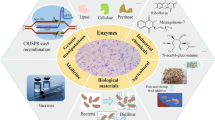Summary
The application of an inducible regulation system using the trytophanase operon promoter (TPase promoter; Ptna) was examined for its high expression of the tryptophan synthase (TS) gene in Escherichia coli. The main problem in the application of Ptna for industrial purposes is catabolite repression by glucose, since glucose is the most abundant carbon source. However, this problem could be avoided by changing glucose to an organic acid, such as succinate, fumarate, malate and acetate, in the course of cultivation after glucose initially added was completely consumed. Under these conditions, l-tryptophan was also used to induce tryptophan synthase. Thus, the specific activity of TS in E. coli strain no. 168 harbouring pBR322F-PtnaTS was increased 500-fold compared to that of the cultured host strain. About 1 mol l-tryptophan/l reaction mixture was formed from indole and l-serine at 37° C for 3.5 h.
Similar content being viewed by others
References
Botsford JL, DeMoss RD (1971) Catabolite repression of tryptophanase in Escherichia coli. J Bacteriol 105:303–312
Bradford MM (1976) A rapid and sensitive method for the quantitation of microgram quantities of protein utilizing the principle of protein-dye binding. Anal Biochem 72:248–254
Deeley MC, Yanofsky C (1981) Nucleotide sequence of the structural gene for tryptophanase of Escherichia coli K-12. J Bacteriol 147:787–796
Deeley MC, Yanofsky C (1982) Transcription initiation at the tryptophanase promoter of Escherichia coli K-12. J Bacteriol 151:942–951
Freundlich M, Lichstein HC (1960) Inhibitory effect of glucose on tryptophanase. J Bacteriol 80:633–638
Kawai S, Mizutani S, Iijima S, Kobayashi T (1986) On-off regulation of the tryptophan promoter in fed-batch culture. J Ferment Technol 64:503–510
Matsui T, Sato H, Sato S, Mukataka S, Takahashi J (1990) Effects of nutritional conditions on plasmid stability and production of tryptophan synthase by a recombinant Escherichia coli. Agric Biol Chem 54:619–624
Nakazawa H, Enei H, Okumura S, Yoshida H, Yamada H (1972) Enzymic preparation of l-tryptophan and 5-hydroxy-l-tryptophan. FEMS Lett 25:43–45
Ogura T, Miki R, Hiraga S (1980) Copy-number mutants of the plasmid carrying the replication origin of the Escherichia coli chromosome: evidence for a control region of replication. Proc Natl Acad Sci USA 77:3993–3997
Sargent MG (1968) Rapid fixed-time assay for penicillinase. J Bacteriol 95:1493–1494
Smith DH, Yanofsky C (1962) Enzymes involved in the biosynthesis of tryptophan. Methods Enzymol 5:794–806
Ward DF, Yudkin MD (1976) Mutations in Escherichia coli that relieve catabolite repression of tryptophanase synthesis: tryptophanase promoter-like mutations. J Gen Microbiol 92:133–137
Wood WA, Gunsalus IC, Umbreit WW (1947) Function of pyridoxal phosphate: resolution and purification of the tryptophanase enzyme of Escherichia coli. J Biol Chem 170:313–321
Yukawa H, Kurusu Y, Shimazu M, Terasawa M, Ohta A, Shibuya I (1985) Stabilization of the mini-F fragment of a pBR322 derivative bearing the tryptophan operon in Escherichia coli. Agric Biol Chem 19:3619–3622
Yukawa H, Kurusu Y, Shimazu M, Yamagata H, Terasawa M (1987) Maintenance of a mini-F recombinant plasmid in E. coli and expression of its tryptophan synthase genes. Process Biochem 22:165–168
Yukawa H, Kurusu Y, Shimazu M, Yamagata H, Terasawa M (1988) Stabilization of an E. coli plasmid by a mini-F fragment of DNA. J Ind Microbiol 2:323–328
Author information
Authors and Affiliations
Additional information
Offprint requests to: H. Yukawa
Rights and permissions
About this article
Cite this article
Terasawa, M., Inui, M., Uchida, Y. et al. Application of the tryptophanase promoter to high expression of the tryptophan synthase gene inEscherichia coli . Appl Microbiol Biotechnol 34, 623–627 (1991). https://doi.org/10.1007/BF00167911
Received:
Accepted:
Issue Date:
DOI: https://doi.org/10.1007/BF00167911




